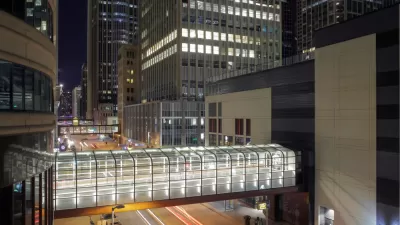The Minneapolis area yields two case studies of troubled sites, home to big box retailers, finally rejoining the community.
Bill Lindeke tells the story of the Lake Street Kmart in Minneapolis, which interrupts the city's most famous street, Nicollet Avenue, on its way to and from downtown.
According to Lindeke, "[The Kmart is] a remnant of desperate times, when Minneapolis tried to bulldoze its way to economic relevance by creating an urban shopping mall. When the original deal fell through, faced with vacant lots, the City Council reluctantly turned to a Kmart proposal that came with a bitter poison pill: replacing one of the city’s key intersections with a massive parking lot straight out of the suburbs."
Such a development presents challenges for "reuse and rehab," according to Lindeke, but he finds examples of redevelopment progress, "after years of struggle and blight," with some examples in Cottage Grove and Minneapolis.
In the Cottage Grove example, a Home Depot in the city's Gateway North area closed eight years ago. For years, the city found it difficult to find a replacement tenant for the building or to redevelop the site. Recently, however, Iowa-based grocer Hy-Vee has been announced as the new tenant in the 116,000-square-foot building. Lindeke offers more details on the difficulties in finding a new tenant, which even involved an episode with the mayor of the city stopping just short of calling for a boycott of Home Depot.
Meanwhile, back at the Lake Street Kmart in Minneapolis, Peter Callaghan recently reported progress for conditions at that location, when city officials approved a $5.3 million purchase of some of the site. Another purchase option for the rest of site is expected soon. Callaghan's coverage of that development pitches the purchase as a chance to reconnect Nicollet Avenue.
FULL STORY: The white elephant in the room — what to do with an old big-box store?

Maui's Vacation Rental Debate Turns Ugly
Verbal attacks, misinformation campaigns and fistfights plague a high-stakes debate to convert thousands of vacation rentals into long-term housing.

Planetizen Federal Action Tracker
A weekly monitor of how Trump’s orders and actions are impacting planners and planning in America.

In Urban Planning, AI Prompting Could be the New Design Thinking
Creativity has long been key to great urban design. What if we see AI as our new creative partner?

Cal Fire Chatbot Fails to Answer Basic Questions
An AI chatbot designed to provide information about wildfires can’t answer questions about evacuation orders, among other problems.

What Happens if Trump Kills Section 8?
The Trump admin aims to slash federal rental aid by nearly half and shift distribution to states. Experts warn this could spike homelessness and destabilize communities nationwide.

Sean Duffy Targets Rainbow Crosswalks in Road Safety Efforts
Despite evidence that colorful crosswalks actually improve intersection safety — and the lack of almost any crosswalks at all on the nation’s most dangerous arterial roads — U.S. Transportation Secretary Duffy is calling on states to remove them.
Urban Design for Planners 1: Software Tools
This six-course series explores essential urban design concepts using open source software and equips planners with the tools they need to participate fully in the urban design process.
Planning for Universal Design
Learn the tools for implementing Universal Design in planning regulations.
Appalachian Highlands Housing Partners
Gallatin County Department of Planning & Community Development
Heyer Gruel & Associates PA
Mpact (founded as Rail~Volution)
City of Camden Redevelopment Agency
City of Astoria
City of Portland
City of Laramie





























